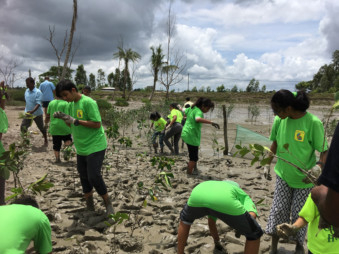
Dubai: Members of the youth environmental group, Green Hope UAE, have just returned from a biodiversity conservation project in the Sundarbans, India, which is the world’s largest coastal mangrove forest.
Biodiversity conservation is one of our major focus areas and in this regard we have been working to raise awareness about several endangered ecosystems, amongst which mangroves are one of the most fragile. These mangrove belts are home to a varied spectrum of flora and fauna and they also help to protect our shores from tidal waves. However, human encroachment and pollution are rapidly depleting these mangroves and most of this change is irreversible.
The Sundarbans are also home to the Bengal tiger, which is now a critically endangered species and faces the same threat as its mangrove habitat. Green Hope UAE decided to gain first-hand knowledge about the situation on the ground, and also to engage with the local population to educate them about conservation, so that they would work to conserve the mangroves and live in harmony with their surroundings.
A team of 28 members from UAE and Oman visited the Sundarbans. Over the course of our trip, we planted over 300 mangrove saplings on an island that was destroyed by Cyclone Aila, which struck in 2009. These mangroves will now provide natural barriers for that island.
We travelled by boat through the densely forested mangroves, visiting several villages situated on the riverine islands, and interacted closely with the residents.
They did not have electricity or running water and the residents mostly lived off agriculture and forest produce. We conducted four workshops for the residents and village students, and explained to them the need to protect the environment, to keep it clean, avoid pollution and the importance of conserving the mangroves.
They were extremely open to our ideas and understood the need for a long term approach wherein both humans and the environment could live and flourish off each other. We used art, music and dance to create awareness.
During our visit we also conducted village clean-ups and worked with the local people to collect the litter from the village roads. This action demonstrated to the villagers the need to dispose off litter in a proper manner and we also explained to them the advantages of recycling and to do away with plastic.
We also visited a tribal village where we distributed clothes, torches, umbrellas, chocolates and school supplies, which we had carried with us. The smiles on their faces really made our efforts worthwhile.
We returned from the Sundarbans full of hope that we had made a difference in the lives of the people living amongst the mangroves and that they would now work to conserve it for generations to come.
— The reader is the Dubai-based founder and president of the Green Hope UAE and a youth ambassador of the World Future Council.
Be a community reporter. Tell us what is happening in your community. Send us your videos and pictures at readers@gulfnews.com








